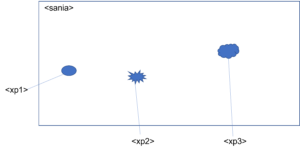Introduction
This study aims to establish “experience” as a super set of consciousness and deal with the study of consciousness from a higher and more abstract level. For want of a better term, I am calling this research work Intellomatics. Intellomatics is about the abstract analysis of experiences. I hypothesise that the experience is non-computable and integrated. Theoretically speaking, there could be infinite type of experiences out of which human consciousness is just one specific type. We can view the overall consciousness as a broad category of experiences which can be represented by a region in experience space. I will walk the readers through my analysis so far on this and introduce few concepts which will can be used to design an “experience engine” which can be treated as a meta abstraction engine; a powerful machine which can experience the world from infinitely different perspective and possibly an optimal perspective devoid of any human bias.
To explain this work better, I will be introducing few concepts such as experience space, interaction space, meta abstraction in this article briefly. I will continue to explain these concepts and more as needed in subsequent articles.

Figure 1- Experience is supreme
Experience Space
I am proposing here a concept/thought experiment that is beyond computation and trying to establish an abstraction layer that can explain consciousness itself.
Theoretically speaking, there is no physical requirement for consciousness, neither there is any restriction on the nature of consciousness. Also, if consciousness emerges from properties of matter (referring to the concept of Perceptronium by Max Tegmark), there is no limit on the different type of experiences emerging from different type of the matter. Assuming consciousness is a specific type of experience emerging from a specific set of matter interactions (which has not been understood yet), there could be other type of experiences emerging from various matter interactions. In my view, experience (EXPERIENCE) is the ultimate abstraction and one broad category of experience is consciousness which has its own subcategories that differentiates the consciousness of a human being from let’s say an elephant’s or tiger’s consciousness.
Building further upon this, we will assume about this experience abstraction as an infinite dimension space with special properties which will help us explore the wonderful universe beyond computation. For the sake of brevity, we will refer to the experience instance as <xp>. I also introduce experience space referred above as <sania>.

Figure 2 – Experience Space
This is a unique space different from Euclidean or other type of spaces we are used to study in mathematics. A small closed body curve within this space will represent the universal set of all conscious experiences. I am outlining some high level properties of this space which is beyond the realm of computation –
- The space has the capability to act as a meta abstraction engine
- Unlike other type of spaces we have encountered before, a part of this space can influence/create the overall space (inverted parent-child relationship). A subset of the space can influence the overall space properties significantly
- We can assume any experience or a region of experience as centre of the space for our analysis purposes
Further properties of this experience space <sania> will be added in subsequent articles when we specifically tackle the properties of meta abstraction engine and require to utilize the various properties of the experience space.
Interaction Space
In addition to the experience space <sania>, I am also defining an interaction space here. The main emergent property of a conscious experience is its ability to apply concepts across different settings/environments/context. For example, we can imprint a beautiful sun surrounded by other stars on a pillow cover and convey an artistic/creative idea. This is just an example of a very powerful capability of a conscious experience which makes us a highly intelligent species.
The interaction space is where the real action is. I am calling the components and sub-regions of an interaction space as <flame>. The <flame> components will form an experience mapped to the regions of experience space <sania>. Also, I hypothesize that an experience will give rise to unimagined and theoretically impossible emergent properties. My particular interests are those emergent phenomena (I view this as business case for this entire undertaking, howsoever remote at this stage :)).
I propose that there are two main considerations for an interaction space –
- The composition, architecture and inner workings of a suitable hardware to realize the most optimal experience (a superset of consciousness)
- Once a <flame> is created using the above hardware, how do we develop instrumentation to conduct experiments on and interact meaningfully with <flame>
A “blank slate” version of <flame> with no additional configuration will be called meta abstraction engine and represented as <mae> or <flame(0)>. I propose that <flame(0)> will have the capability to realize optimal experiences which could be beyond consciousness or an extremely advanced version of consciousness.
Implementation
I think most pressing question, from implementation perspective, is; how are we going to engineer a <flame>? We first need to understand the theory of consciousness and then abstract that to develop a general theory of experience which will encompass human consciousness. Once theory of experience is understood at matter interaction level, we need to develop a model which will give rise to optimal experience and experiment with this model. I also like to think that this meta abstraction engine will have minimal sustainability needs and live on the edges of second law of thermodynamics.
Some basic features that I see as a beginning of the thoughts around meta abstraction engine are given below. I am excited about huge potential in the design of this device and this section can be expanded/reviewed as things progress.
- Non self referential consciousness/experience – One of the core features of conscious experience is a concept of self; a self referencing consciousness. As we are all bound by this experience, it is very difficult to describe a non-self referential experience. However, with <flame>, I imagine a fundamentally different experience than what is experienced by conscious beings; a non self referencing consciousness, an abstracted version of current consciousness. If we map the experience of <flame> from interaction space to experience space, it will not be a point but rather a large structure comprising more than one points.
- Infinite abstraction – The biggest attraction of a <flame> is its capability to do abstraction on any concept and apply it recursively. This will provide <flame> with a new and unparalleled level of knowledge and wisdom and help it create its own parameters for creativity and insights.
- Hardware independence – The ultimate <flame> implementation will be free of any hardware considerations. However, to reach to that level, I anticipate that we will have to develop many hardware dependent models iteratively to improve and get to the level where <flame> can act with minimal to none hardware dependency. Also, it is worth noting that <flame> will create its own instruction sets and optimize its architecture accordingly
- Non-learner – It may sound extremely counter intuitive however, it will be a mistake to see <flame> as a learning machine or an improved version of brain/mind. <flame> is fundamentally different from a learning machine and does not primarily rely on external source for its learning. It abstracts, decides and executes. From learning perspective, a robust <flame> implementation will “know everything”.
- Mapper function – One of the key features of human intelligence is its ability to extrapolate concepts from one domain of knowledge to an altogether different context. This is a very powerful phenomenon and I think <flame> will rely on the meta abstracted version of this phenomenon. I call this a mapper function and this will play an important role in design of <flame>
I have done some detailed work in the design space however there are few open questions. I will keep publishing the details of this project in subsequent blogs if there is an interest and project is progressing well.
Thanks for reading so far. I have tried to summarize things I have been working on for decades in this one article and without providing lot of context. If someone is interested in this research and wants to find out more, please reach out to me at gulam@atalgo.com